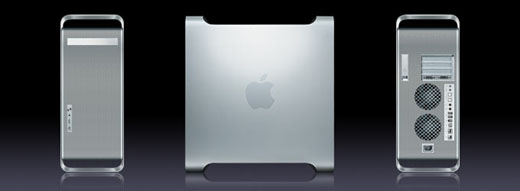No more mysteries: Apple's G5 versus x86, Mac OS X versus Linux
by Johan De Gelas on June 3, 2005 7:48 AM EST- Posted in
- Mac
Introduction
It is a professional 64 bit Dream machine with supersonic speed! It is beautiful. It is about the ultimate user friendliness. It is about a lifestyle. It is a class apart. You guessed it - I am parroting Apple’s marketing.For some reason, the performance of Apple’s gorgeous machines has been wrapped in a shroud of mystery. Yes, you could find a benchmark here and there, with one benchmark showing that the PowerMac is just a mediocre PC while another shows it off as a supercomputer, the unchallenged king of the personal computer world.

If you like a less performance-obsessed article about Apple, OS X and the G5, you should definitely give Anand’s articles in the Mac section on AnandTech a read...
In this article, you will find a pedal to the metal comparison of the latest Xeon DP 3.6 GHz (Irwindale), Opteron 250, Dual G5 2.5 GHz and Dual G5 2.7 GHz.
Scope and focus
Apple’s PowerMac is an alternative to the x86 PC, but we didn’t bother testing it as a gaming machine. Firstly, you have to pay a big premium to get a fast video card – as a standard, you get the ATI Radeon 9650 - even on the high-end PowerMacs. Secondly, there are fewer games available on this platform than on the x86 PC. Thirdly, hardcore gamers are not the ones buying Apples, but rather, creative professionals.So, we focus on workstation and server applications, especially the open source ones ( MySQL, Apache) as Apple is touting heavily on how important their move to an “open source foundation” is.
The 64 bit Apple Machines were running OS X Server 10.3 (Panther) and OS X Server 10.4.1 (Tiger), while our x86 machines were also running a 64 bit server version of a popular Open Source Operating Unix system: SUSE Linux SLES 9 (kernel 2.6.5). We also included an older Xeon 3.06 GHz ( Galatin, 1 MB L3) running SUSE SLES 8 (kernel 2.4.19) just for reference purposes. Some of the workstation tests were done on Windows XP SP2.










116 Comments
View All Comments
Icehawk - Friday, June 3, 2005 - link
Interesting stuff. I'd like to see more data too. Mmm Solaris.Unfortunately the diagrams weren't labeled for the most part (in terms of "higher is better") making it difficult to determine the results.
And the whole not displaying on FF properly... come on.
NetMavrik - Friday, June 3, 2005 - link
You can say that again! NT shares a whole lot more than just similarites to VMS. There are entire structures that are copied straight from VMS. I think most people have forgotten or never knew what "NT" stood for anyway. Take VMS, increment each letter by one, and you get WNT! New Technology my a$$.Guspaz - Friday, June 3, 2005 - link
Good article. But I'd like to see it re-done with the optimal compiler per-platform, and I'd like to see PowerPC Linux used to confirm that OSX is the cause of the slow MySQL performance.melgross - Friday, June 3, 2005 - link
I was just thinking back about this and remembered something I've seenComputerworld has had articles over the past two years or so about companies who have gone to XServes. They are using them with Apache, SYbase or Oracle. I don't remember any complaints about performance.
Also Oracle itself went to XServes for its own datacenter. Do you think they would have done that if performance was bad? They even stated that the performance was very good.
Something here seems screwed up.
brownba - Friday, June 3, 2005 - link
johan, i always appreciate your articles.you've been /.'d !!!!
and anandtech is holding up well.
good job
bostrov - Friday, June 3, 2005 - link
Since so much effort went in to vector facilities and instruction sets ever since the P54 days, shouldn't "best effort" on each CPU be used (use the IBM compiler on G5 and the Intel compiler on x86) - by using gcc you're using an almost artifically bad compiler and there is no guarantee that gcc will provide equivilant optimizations for each platform anyway.I think it'd be very interesting to see an article with the very best available compilers on each platform running the benchmarks.
Incidently, intel C with the vector instruction sets disabled still does better.
JohanAnandtech - Friday, June 3, 2005 - link
bostrov: because the Intel compiler is superb at vectorizing code. I am testing x87 FPU and gcc, you are testing SSE-2 performance with the Intel compiler.JohanAnandtech - Friday, June 3, 2005 - link
minsctdp: A typo which happened during final proofread. All my original tables say 990 MB/s. Fixed now.bostrov - Friday, June 3, 2005 - link
My own results for flops 2.0: (compiled with Intel C 8.1, 3.2 Ghz Prescott with 160 Mhz - 5:4 ratio - FSB)flops20-c_prescott.exe
FLOPS C Program (Double Precision), V2.0 18 Dec 1992
Module Error RunTime MFLOPS
(usec)
1 1.7764e-013 0.0109 1288.7451
2 -1.4166e-013 0.0082 852.7242
3 8.1046e-015 0.0067 2531.7045
4 9.0483e-014 0.0052 2858.2062
5 -6.2061e-014 0.0140 2065.6650
6 3.3640e-014 0.0100 2906.2439
7 -5.7980e-012 0.0327 366.4559
8 3.7692e-014 0.0111 2700.8968
Iterations = 512000000
NullTime (usec) = 0.0000
MFLOPS(1) = 1088.7826
MFLOPS(2) = 854.7579
MFLOPS(3) = 1609.7508
MFLOPS(4) = 2753.5016
Why are the anandtech results so poor?
melgross - Friday, June 3, 2005 - link
I thought that GCC comes with Tiger. I have read Apple's own info, and it definitely mentions GCC 4. Perhaps that would help the vectorization process.Altivec is such an important part of the processor and the performance of the machine that I would like to see properly written code used to compare these machines.